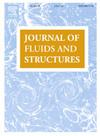Numerical strategy of modelling flexible vegetation flows using a semi-resolved numerical model by means of distributed virtual body forces
IF 3.4
2区 工程技术
Q1 ENGINEERING, MECHANICAL
引用次数: 0
Abstract
Aquatic flexible vegetation is widespread in rivers, lakeshores, harbors, and coastal areas and plays an important role in the riverine and coastal ecosystems. The flow with flexible vegetation is difficult to simulate due to the complex motions of flexible vegetation and fluid. This work proposes and validates a semi-resolved numerical model coupling the computational fluid dynamics (CFD) and flexible rod dynamics (FRD) using a promoted two-way domain expansion method. The governing equations in the FRD model are solved by the finite element method (FEM), and the CFD is implemented by the finite volume method (FVM). The vegetation effect is added by introducing body forces into the Reynolds-averaged Navier-Stokes equations as point source terms. To mimic the flexible vegetation stem with the anisotropic cross-section, a named distributed virtual body forces method (DVBFM) was first proposed to model the fluid-solid body coupling. A test case of flow around a single flexible plate was first designed to strictly validate the numerical scheme. The model was then further validated by experimental results of flow with a gently undulating patch of flexible plates. Finally, the test case of flow through a wavy patch of flexible vegetation, mimicked by the plates, was used as a benchmark to validate the usability of the model for flexible vegetation flow simulation in a practical engineering sense.
基于分布式虚拟体力的半分辨数值模型模拟柔性植被流的数值策略
水生柔性植被广泛存在于河流、湖滨、港口和沿海地区,在河流和沿海生态系统中起着重要作用。由于柔性植被与流体的复杂运动,柔性植被流场的模拟比较困难。本文采用一种改进的双向域展开方法,提出并验证了一种耦合计算流体动力学(CFD)和柔性杆动力学(FRD)的半解析数值模型。FRD模型中的控制方程采用有限元法求解,CFD采用有限体积法求解。通过在reynolds -平均Navier-Stokes方程中引入体力作为点源项,增加了植被效应。为了模拟具有各向异性截面的柔性植被茎秆,首次提出了一种分布式虚拟体力法(DVBFM)来模拟流固耦合。首先设计了单柔性板绕流的试验用例,严格验证了数值格式的正确性。然后,通过柔性板缓波块流动的实验结果进一步验证了该模型。最后,以板材模拟柔性植被波浪形斑块的流动测试为基准,验证了该模型在实际工程意义上柔性植被流动模拟的可用性。
本文章由计算机程序翻译,如有差异,请以英文原文为准。
求助全文
约1分钟内获得全文
求助全文
来源期刊

Journal of Fluids and Structures
工程技术-工程:机械
CiteScore
6.90
自引率
8.30%
发文量
173
审稿时长
65 days
期刊介绍:
The Journal of Fluids and Structures serves as a focal point and a forum for the exchange of ideas, for the many kinds of specialists and practitioners concerned with fluid–structure interactions and the dynamics of systems related thereto, in any field. One of its aims is to foster the cross–fertilization of ideas, methods and techniques in the various disciplines involved.
The journal publishes papers that present original and significant contributions on all aspects of the mechanical interactions between fluids and solids, regardless of scale.
 求助内容:
求助内容: 应助结果提醒方式:
应助结果提醒方式:


